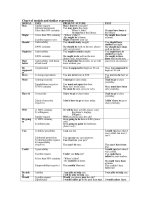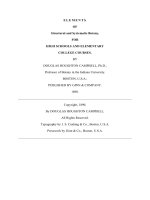Textile fibers - Definition of Fiber and Textile Fibers
Bạn đang xem bản rút gọn của tài liệu. Xem và tải ngay bản đầy đủ của tài liệu tại đây (242.13 KB, 49 trang )
CHAPTER ONE
INTRODUCTION TO TEXTILE FIBERS
Definition of Fiber and Textile fibers
Fiber:
It is defined as one of the delicate, hair portions of the tissues of a plant
or animal or other substances that are very small in diameter in relation
to there length.
A fiber is a material which is several hundred times as long as its thick.
Fibres have been defined by the Textile Institute as units of matter
characterized by :
flexibility,
fineness
high ratio of length to thickness.
Cont…
Other characteristics might be added, if the fibre is to be of any use for general
textile purposes, a sufficiently high temperature stability and a certain
minimum strength and moderate extensibility.
The characteristic dimensions of fibres are the basis of their use and need to be
stressed:
individual fibres (or elements of a continuous filament) weigh only a few
micrograms
their length/width ratio is at least 1000:1
It is the basic structural element of textile products.
It is a smallest textile component which is microscopic hair like substance that
may be manmade or natural.
Textile Fiber:
Textile fiber has some characteristics which differ between fiber to Textile fiber.
Textile fiber can be spun into a yarn or made into a fabric by various methods including
weaving, knitting, braiding, felting, and twisting.
The essential requirements for fibers to be spun into yarn include a length of at least 5
millimeters, flexibility, cohesiveness, and sufficient strength.
Other important properties include elasticity, fineness, uniformity, durability, and luster.
Banana fiber is one kind of fiber but it is not a textile fiber. Because it can not fill up the
above properties. So we can say that all fiber are not textile fiber.
Cont…
ordinary textile fibres must be, at least partly, elastic up to breaking extensions between 5 and 50%.
This is an unusual intermediate range of extensibility, since glasses and crystalline solids are less
extensible, whereas rubbers are much more extensible.
all textile fibers are partially oriented, linear polymers.
A remarkable fact is that almost all the general textile fibre market is met by six polymer types:
the natural polymers,
cellulose and proteins,
the synthetic (manufactured) polymers, polyamide, polyester, polyolefin and vinyl (including acrylic).
Essential properties Textile Fibers
Basic Textile Fiber Properties
There are several primary properties necessary for a polymeric material to
make an adequate fiber.
Certain other fiber properties increase its value and desirability in its
intended end-use but are not necessary properties essential to make a fiber.
Such secondary properties include :
moisture absorption characteristics,
fiber resiliency, abrasion resistance,
density,
luster,
chemical resistance,
thermal characteristics,
flammability.
CONT
Some Primary Properties of Textile Fibers are:
Fiber length to width ratio,
Fiber uniformity,
Fiber strength and flexibility,
Fiber extensibility and elasticity,
Fiber cohesiveness.
CONT.
Length to Width Ratio: Fibrous material must possess adequate staple or
fiber length and the length must be considerably higher (1000 times) then
the width of the fiber.
Length to Width Ratio of Some Typical Fiber as follows:
•
But to be a fiber the staple length must not be less than ½ inch. According
to the length, the fibers may be classified into the following two categories:
Staple Fiber, Filament Fiber
Fiber Length to Width Ratio
Cotton 1400
Wool 8000
Flax 170
Silk 330000
Cont…
Strength:
Strength of any material is determined by the breaking strength (that is tenacity strength) which
express as force per unit cross-sectional area.
With this term (strength / tensile strength) we may describe the ability of a bundle of fiber of yarn
to resist breakage under tension / load.
In case of describing the strength of individual fiber the term tenacity is usually used.
Tenacity :force per unit linear density
That is, tenacity = breaking load/ mass per unit length
Tenacity express as grams per tex(gtex) or grams per denier(gd).
Tenacity of Some Common Fiber:
Fiber Grams Per Denier
Raw cotton 3.0 - 4.9
Jute 3.0 - 5.8
Flax 2.6 - 7.7
Ramie 5.5
Silk 2.4 - 5.1
Wool 1.1 - 1.7
Hemp 5.8 - 6.8
Cont…
Flexibility:
It is one of the essential property of textile fiber.
The fibers should be sufficient by poliable, then only it can be wrapped around another fiber during
spinning.
Many substance in nature resemble fibrous forms but they are note pratical fibers as they are stiff and
brittle.
Cohesiveness:
It may also be termed as spinning quality of fiber.
It is the property of an individual fiber by virtue of which the fibers are hold on to one another when the
fibers are spun into yarns.
Cont….
Uniformity:
It may describe the similarities in length of fiber which are spun
into yarn.
To make a good quality yarn, it is important that the fibers must be
similar in length and width in spinning quality and in flexibility .
There is no problem in producing uniform manmade fibers but for
natural fiber uniformity is difficult to achieve.
So for natural fiber it is essential to blend many batches in order to
manufacture good quality yarn and fabrics.
Cont….
Elastic Recovery:
Elastic recovery is the percent to return from elongation towards its original length.
If a fiber returns to its original length from a specified amount of attenuation, it is said
to have 100% elastic recovery at x-percent elongation.
Elastic recovery is expressed as percentage.
The elasticity or elastic recovery of a fiber is determined by several aspects like what
type of load is applied and how many times it is held in the stretched position.
CLASSIFICATION OF FIBRES
The history of
Traces of natural fibers have been located to ancient civilizations all over
the globe.
For many thousand years, the usage of fiber was limited by natural fibers
such as flax, cotton, silk, wool and plant fibres for different applications.
Fibers can be divided into natural fibres and man-made or chemical fibres.
Flax is considered to be the oldest and the most used natural fibre since
ancient times.
Classification of Fibres
Natural Fibers
Vegetable Fibres
Animal Fibres
Mineral fibers
Man Made fibers
Regenerated fibres
Synthetic fibres
Inorganic fibres
Inorganic fibres
Cont…
Classification of fibers can be done by:
Type(Natural and manufactured)
Length(Short staple, long staple, continuous filament)
Size(Ultra fine, fine, regular, course)
Classification of Fibres
NATURAL FIBRE
Any hair like raw material directly obtainable from an
animal, vegetable or mineral source that can be convertible
after spinning into yarns and then into fabric.
Under them there are various categories:
Plant
Animal
minerals
Vegetable fibers
They can be further on classified as:
fibre occurring on the seed(raw cotton, java cotton)
phloem fiber (flax, ramie ,hemp, jute)
tendon fibre from stem or leaves (manila hemp, sisal hemp etc)
fibre occurring around the trunk (hemp palm)
fibre of fruit/ nut shells(coconut fibre – Coir) cotton and linen are the
most important among them.
Cont…
Bast fibres
Low Lignin content – Linen or Flax (raw and bleached)
and Ramie
High Lignin content – Jute, Hemp
Cotton
Cotton is a soft fibre that grows around the seeds of the cotton plant
.
cotton fibre grows in the seed pod or boll of the cotton plant . each
fibre is a single elongated cell that is flat twisted and ribbon like
with a wide inner hollow (lumen).
Composition
90% cellulose,6% moisture and the remainder fats and impurities.
the outer surface is covered with a protective wax like coating
which gives fibre an adhesive quality.
PROPERTIES
It has 8% moisture regain
The cellulose is arranged in a way that gives cotton unique properties of strength,
durability, and absorbency.
it is fresh , crisp , comfortable ,absorbent , flexible, has no pilling problems and has
good resistance to alkalis.
it has poor wrinkle resistance, shrinkage, poor acid resistance , less abrasion
resistance , susceptible to damage by moths and mildew, need slots of maintenance
and stains are difficult to remove.
its fibre length ranges from ½ inches to 2inches
it has 10%increase in strength when wet.
it has a flat twisted tube shape.
BAST FIBRE
Bast fibre or skin fibre is fibre collected from the Phloem (the
bast surrounding the stem of a certain plant
Properties
The bast fibres have often higher tensile strength than other kinds,
and ropes, yarn, paper, composites and burlap.
A special property of bast fibers are that the fiber at that point
represents a weak point.
They are obtained by the process called retting
JUTE FIBRE
Jute is one of the cheapest natural fibres and is second only to
cotton in amount produced and variety fibres are composed primarily of the plant cellulose and
lignin .
Properties
Jute is a long, soft, shiny vegetable fibre that can be spun into coarse, strong
It is a lingo -cellulosic fibre that is partially a textile fibre and partially wood.
The plant grows up to a height of 2.5m and its fibre length is about 2m.
it is generally used in geo textiles.
it has a good resistance to microorganisms and insects.
it has low wet strength, low elongation and inexpensive to reduce
RAMIE FIBRE
Ramie is one of the oldest
fibre crops, having been used for.
Properties
Ramie requires chemical processing to de-gum the
fibre.
it is fine absorbent ,quick drying fibre, is slightly
stiff and possesses high natural lustre.
its plant height is 2.5m and its strength is eight times
more than cotton.









